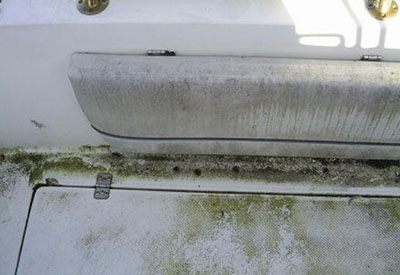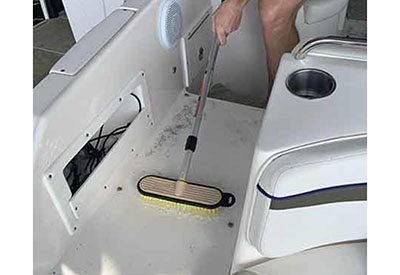Ask Andrew: Gelcoat cleaning

Sept 8, 2022
The worst case ever
As the busy season starts to wind down, many boaters turn to the maintenance that has been neglected or pushed aside for trips and activities aboard. Why now? It’s great to put your boat away clean and ready to go for spring. If you use a marina or contractor for upkeep, now’s a great time to arrange for some winter work when facilities are more available. So here we go.
Gelcoat is a great coating for the marine environment: it’s tough, waterproof, clean, glossy, and can be formed into many edges, patterns and designs. It’s also permeable, soft enough to scrape and gouge, and hard enough to crack.
By summer’s end, on even a well-maintained boat, gelcoat starts to show some wear-and-tear – much of it caused by the environment that the boat is in:
 Gelcoat surfaces start to look faded and chalky
Gelcoat surfaces start to look faded and chalky- The waterline collects growth and scum
- Non-skid surfaces are full of dirty and gunk
- Rubs and scuffs are visible
Now that boat use (for many of us) is slowing down, there’s a lots of tips and tricks that can be used for keeping up the clean, glossy look that we all enjoy:
grime, dirt and algae breeding on a fibreglass boat deck
- Consider a deck polish – this involves using a compound or rubbing compound (often applied by a machine buffer), followed by a wax applied by hand. This will remove oxidation, return the gloss, and protect the gelcoat from fading for the rest of the season
- Clean using soft brush heads, soft pads or cloths. Avoid using hard bristles, scotch-brite or scuffing pads: Yes, they will clean off surface dirt faster, but they may also scratch or damage gelcoat.
- Avoid using power-washers: Yes, they’ll clean up the surface dirt, but they can also cause damage if over-used: breaking/cracking gelcoat, exposing fibreglass, and potentially causing water damage
- Avoid abrasive cleaners (comet comes to mind) in favour of mild, soft soaps
- Search for products that are environmentally conscious: remember, whatever you clean your boat with will end up in the water around the boat.
- Keep in mind exactly what you’re cleaning: cleaning a deck is a much more simple task than cleaning a greasy bilge – but he same rules apply: all the gunk being removed could end pup in the water around the boat
- Waxing is not the same as cleaning: The gelcoat will need to be cleaned before wax is applied (otherwise the wax will lock in dirt and grime). Also keep in mind that wax offers little in UV protection – it will need multiple applications throughout the season to keep up with sun exposure
- Waterline gunk and grime can be tough. Its highly tempting to use abrasive scrubbers and harsh chemicals to remove any underwater growth. I’ve had luck with cleaners that have a low PH level

the right cleaners, tools and elbow grease make it right!
- Dirt is dirt and a stain is a stain, and they should be approached differently: Dirt can be removed with a soap from the gelcoat surface. Stains are imbedded in the gelcoat surface and may need a fibreglass-specific cleaner to remove
- If the gelcoat has oil or grease on the surface, this will need to be removed first. The most effective ways to do this are by using MEK (Methyl ethyl ketone), or acetone. Wear appropriate PPE: gloves and a respirator: both have noxious fumes and can irritate the skin. Again: keep in mind where these chemicals might end up after the fact.
- Saltwater has a negative effect on gelcoat: when its left to dry on a gelcoat surface, it crystalizes, which in turn can magnify the sun’s rays, breaking down the wax protection. So after use in salt water, make sure to wash the boat’s surfaces down with freshwater.
- If your boats is transported on a trailer, try to wash and wipe down after a trip down the road: remove any road grime, dirt, salt and under-the-waterline gunk after each trip
- For those who store on a trailer: try to find a good shady spot to keep your boat, but avoid spots near trees (which can drop foliage and debris and leave staining on the boat’s surfaces).
- If using an acrylic or polymer coating (like Poli Glow), be sure that it is applied to a completely clean and bare surface (without any wax): If wax is trapped between the coating and the hull, it will yellow over time.
I hope these tips and tricks will help your boat stay the envy of your dock-mates for the rest of this season or for next year!
 Andrew McDonald is the owner of Lakeside Marine Services – a boat repair/maintenance firm based in Toronto. Andrew has worked in the marine industry for 12 years and is a graduate of the Georgian College ‘Mechanical Techniques – Marine Engine Mechanic’ program.
Andrew McDonald is the owner of Lakeside Marine Services – a boat repair/maintenance firm based in Toronto. Andrew has worked in the marine industry for 12 years and is a graduate of the Georgian College ‘Mechanical Techniques – Marine Engine Mechanic’ program.
Questions or comments for Andrew? Email him directly via: askandrew@lakesidemarineservices.ca




























